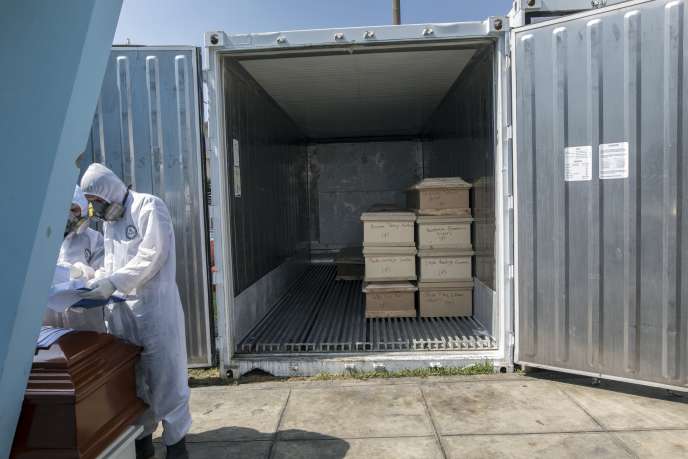The Covid-19 pandemic has killed more than 325,000 people worldwide since its appearance in December in China, according to a report established by Agence France-Presse (AFP) from official sources, Wednesday, May 20, at 20 hours (Paris time).
In total, more than 4,943,000 cases have been officially diagnosed in 196 countries and territories. The United States is the most affected country in terms of number of deaths and cases, with 93,400 deaths (1,561 additional deaths in one day) for 1.55 million people infected. This is followed by the United Kingdom with 35,704 deaths, Italy (32,330), France (28,132) and Spain (27,888).
The World Health Organization said on Wednesday 106,000 new cases worldwide, the largest increase in a single day since the start of the pandemic, saying it feared its consequences in the poorest countries.
Page Contents
The epidemic is worsening in Latin America, concerns in Peru
With more than 104,000 contaminations, the Peru is the second most affected country in Latin America, after Brazil (more than 271,000 cases), by the Covid-19 epidemic.
The latest official death toll shows 3,024 deaths, as the country entered its ninth week of confinement. Contamination and death have increased threefold since April 30. While the number of people hospitalized is 7,533, health personnel continue to denounce the shortages of equipment and drugs in public hospitals in the country, such as Miguel Armas, a nurse from Lima, to the AFP:
"There are already a lot of infected workers, a lot of dead, we do not have the security necessary to survive in this pandemic. "
At the same time, the crematoriums in the capital's cemeteries operate day and night to cremate the deceased patients of Covid-19. In addition to the capital, the new coronavirus is wreaking havoc in isolated villages and villages in the Peruvian Amazon. Faced with this emergency, Peru and Colombia have set up a "Covid-19 binational committee" to try to contain the epidemic in the border areas of the Amazon, mainly inhabited by Indians.

Peru is the third Latin American country in number of deaths, behind Brazil (17,971 dead) and Mexico (5,666), according to the latest official figures. At Brazil, while the daily toll peaked at 1,179 deaths, the health ministry recommended the use of chloroquine and hydroxychloroquine for patients slightly affected by Covid-19, after weeks of pressure from the president, Jair Bolsonaro, with a view to imposing it as a miracle cure.
At Mexico, the authorities of the capital Mexico, the epicenter of the disease, have announced a plan to exit containment which will allow from 1er June the gradual recovery of the economy, provided that hospital capacity is not congested.
Trump pleads for a real G7
Donald Trump spoke on his twitter account on Wednesday of the possibility of gathering the leaders of the G7 in June at Camp David, Maryland, and not by videoconference as had been decided because of Covid-19.
“The other members (of the G7) are also starting their return. It would be a great symbol for everyone. Standardization! "
Now that our Country is “Transitioning back to Greatness”, I am considering rescheduling the G-7, on the same or si… https://t.co/Iwr9kZFMoL
The reactions of G7 leaders have been cautious. French President Emmanuel Macron said to himself "Willing to go to Camp David if sanitary conditions allow". Prime Minister Justin Trudeau stressed the importance of studying "What measures would be put in place" and "The recommendations of the experts". Likewise, German Chancellor Angela Merkel has remained ambiguous about her intentions. "Whatever form the G7 meeting takes, a videoconference or something else, I will certainly fight for multilateralism", she said in Berlin.
In addition, the United States announced the donation of 200 respirators to help Russia in the fight against Covid-19, a few weeks after the dispatch by Moscow of similar material in New York, then major focus of the American epidemic. .
The European Union recommends wearing a mask when flying
In a document released on Wednesday, two European Union agencies – the European Aviation Safety Agency (EASA) and the European Center for Disease Prevention and Control (ECDC) – recommend physical distancing measures and the wearing of mask for air travel when resuming flights.
The agencies recommend that all passengers and airline staff wear medical masks from the time they enter the departure airport until they arrive at their destination, with a possible exception for children under the age of 6. These masks need to be changed every four hours, and passengers need to make sure they have enough, but companies are also encouraged to have inventory to supply.
A physical distance of 1.50 m is recommended, if possible at all stages of the journey. In the plane, "When permitted by the number of passengers and the configuration of the cabin", Companies “Must guarantee, as far as possible, the physical distance of the passengers” : for example by leaving at least one empty seat between them or by leaving empty every other row.
The International Air Transport Association (IATA), which groups 290 airlines, has already expressed its opposition to such physical distancing measures, believing that they would drop the occupancy rate of aircraft below the break-even point and would drive up ticket prices.
Our selection of articles on the coronavirus
Find all our articles on the coronavirus in our section
On the epidemic
On deconfinement and its challenges




